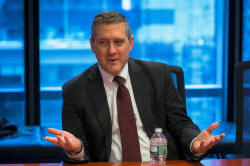|
U.S. inflation path since
2012 is worrisome, policymaker says
 Send a link to a friend
Send a link to a friend
 [May 26, 2017]
By Ann Saphir and Minami Funakoshi [May 26, 2017]
By Ann Saphir and Minami Funakoshi
TOKYO
(Reuters) - The current level of U.S. prices is noticeably lower than
what it would be if the Federal Reserve had delivered on its 2-percent
inflation target, St. Louis Federal Reserve President James Bullard
said, calling the trend "worrisome."
In slides prepared for delivery in Tokyo on Friday, the U.S. central
banker said U.S. prices are now 4.6 percent below the price level path
established from 1995 to 2012, when inflation was growing near the Fed's
target of 2 percent each year.
"This is not as severe as the 1990s Japanese experience, but it is
worrisome," said Bullard, who does not vote on U.S. monetary policy this
year.
Too-low inflation has kept the Fed from raising rates more than three
times since the Great Recession, but since late last year most Fed
policymakers have seen faster rate increases ahead, citing improvements
in the labor market.
Bullard also said he sees minimal impact on long-term bond yields from
reductions in the Fed's balance sheet, which he hopes will start in the
second half of this year.

Bullard, speaking to reporters after the speech, said it was good to cap
the amount of mortgage-backed securities and Treasuries that are allowed
to run off the Fed's balance sheet. However, he was indifferent to what
the size of the caps should be.
The Fed is monitoring subprime auto and student loans but they are not
near danger levels, he added.
U.S unemployment registered 4.4 percent in April, below what Fed
officials believe is a sustainable level. Most Fed officials expect to
raise the target interest rate three times this year, including the
increase they made after their March policy meeting
But Bullard said that a surge in inflation is unlikely even if
unemployment falls further.
With inflation still below 2 percent and inflation expectations and
Treasury yields falling since the Fed raised rates in March, the Fed's
plans for rate increases may be "overly aggressive" he said.
[to top of second column] |

St. Louis Fed President James Bullard speaks about the U.S. economy
during an interview in New York, U.S., on February 26, 2015.
REUTERS/Lucas Jackson/File Photo

The
Fed is expected to raise rates at its June policy-setting meeting, and will
release fresh economic projections at that time.
Bullard, who regards the economy as mired in a low-inflation, low-growth rut,
has said he feels the central bank needs to raise rates only one more time and
should then pause until it is clear the economy has shifted to a higher gear.
MARKET COMMUNICATION
Bullard also told reporters the Bank of Japan must communicate carefully with
markets if it decides to taper its purchases of Japanese government bonds, and
that it would be prudent for the central bank to lay out an exit strategy.
"It's very important to get the communication right," Bullard said. "Otherwise
there will be outsize reaction and cause a lot of global dislocation."
Japan's inflation is nowhere near the BOJ's 2 percent target, but analysts are
growing concerned because the bank's balance sheet has swelled to 90 percent of
the nation's nominal gross domestic product - triple the ratio for the European
Central Bank and nearly four times that of the Fed.
(Writing by Ann Saphir; Additional reporting by Stanley White; Editing by Diane
Craft & Shri Navaratnam)
[© 2017 Thomson Reuters. All rights
reserved.] Copyright 2017 Reuters. All rights reserved. This material may not be published,
broadcast, rewritten or redistributed.
 |